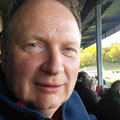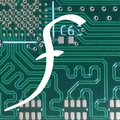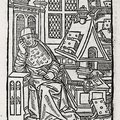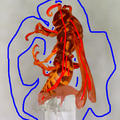 OK, everyone, let's get started. I'm Dan, I'll be moderating today for our guest Jeroen Vleggaar. You might have seen him on his YouTube channel "Huygens Optics", and we're going to talk about Precision Optics today.
OK, everyone, let's get started. I'm Dan, I'll be moderating today for our guest Jeroen Vleggaar. You might have seen him on his YouTube channel "Huygens Optics", and we're going to talk about Precision Optics today.
Welcome, Jeroen! Can you start us off with a little about yourself?
 Sure. Hi everyone. So I am Jeroen and I live in the Netherlands. As long as I can remember I have been interested in all kinds of technology. Dan made this chat about precision optics. But in fact, I do not have a formal education in optics. Almost everything I know about it is from making stuff myself, basically hands on.
Sure. Hi everyone. So I am Jeroen and I live in the Netherlands. As long as I can remember I have been interested in all kinds of technology. Dan made this chat about precision optics. But in fact, I do not have a formal education in optics. Almost everything I know about it is from making stuff myself, basically hands on.
 My background is actually in chemistry. I did a a master in electrochemistry and a PhD on the photochemistry of photoresists. These are the materials used for IC manufacture. Photolithography has always remained a field of interest for me. My first real job started in 1994 at Philips electronics research, where I worked on the development of OLED and polymer-LED display technology.
My background is actually in chemistry. I did a a master in electrochemistry and a PhD on the photochemistry of photoresists. These are the materials used for IC manufacture. Photolithography has always remained a field of interest for me. My first real job started in 1994 at Philips electronics research, where I worked on the development of OLED and polymer-LED display technology.
 From 2001 I have been self-employed, and I did various things involving music, software development, optics and mechanics. About a year ago, also started to make videos for Youtube in my spare time. Anyway, I hope I can answer any questions you might have for me.
From 2001 I have been self-employed, and I did various things involving music, software development, optics and mechanics. About a year ago, also started to make videos for Youtube in my spare time. Anyway, I hope I can answer any questions you might have for me.
 Did the interest in optics come from working with photoresists?
Did the interest in optics come from working with photoresists?
 No I guess long before that. The PhD I did involved a lot of laser spectroscopy, which I also found fascinating.
No I guess long before that. The PhD I did involved a lot of laser spectroscopy, which I also found fascinating.
![]() Can you talk more about that?
Can you talk more about that?
![]() Spectroscopy is fascinating, how did that work with lasers?
Spectroscopy is fascinating, how did that work with lasers?
 In general the properties of light are extremely interesting. @home so it involved looking at reactions with time resolved spectroscopy. Basically short laser pulses.
In general the properties of light are extremely interesting. @home so it involved looking at reactions with time resolved spectroscopy. Basically short laser pulses.
 So you set a reaction in action with one pulse and study it with another one.
So you set a reaction in action with one pulse and study it with another one.
![]() What frequency laser(s) did you use?
What frequency laser(s) did you use?
 is that similar to raman spectroscopy?
is that similar to raman spectroscopy?
 @home basically visible light so frequency doubled YAG and other wavelengths. Including light generated using stimulated Raman.
@home basically visible light so frequency doubled YAG and other wavelengths. Including light generated using stimulated Raman.
 Hi Jeroen, I have seen you videos and they are a great inspiration. I am trying to manifacture a triangle prism (one angle 90° the other two 45°) shaped optical compent but I have the problem that when I try to lap the short faces of that prism it always wants to converge towards a 60° degree prism.
Hi Jeroen, I have seen you videos and they are a great inspiration. I am trying to manifacture a triangle prism (one angle 90° the other two 45°) shaped optical compent but I have the problem that when I try to lap the short faces of that prism it always wants to converge towards a 60° degree prism.
I think I have to fabricate come kind of holder or mount for that such that it keeps the angle do you have a hint on what best to use as a fixture?
 Also I used the excimer lasers, which are also used in photolithography.
Also I used the excimer lasers, which are also used in photolithography.
![]() I've been wanting to make my own 4F correlator (or at least the first half to get the fourier plane). How important is it to have a high quality laser? Or will any old diode laser work? What properties of the laser are important?
I've been wanting to make my own 4F correlator (or at least the first half to get the fourier plane). How important is it to have a high quality laser? Or will any old diode laser work? What properties of the laser are important?
 @flow . Yes you always need to make special fixtures to do polishing. Basically always create a surface larger that your object to keep it flat and straight
@flow . Yes you always need to make special fixtures to do polishing. Basically always create a surface larger that your object to keep it flat and straight
 @andrewjeddeloh. I think it is possible to use just diode lasers, although they come in many different qualities. I would avoid the cheam ebay ones.
@andrewjeddeloh. I think it is possible to use just diode lasers, although they come in many different qualities. I would avoid the cheam ebay ones.
![]() is poor beam divergence the main thing to avoid?
is poor beam divergence the main thing to avoid?
 Jersey, I absolutely love your YouTube channel. I'm normally a machinist by day, but I'm also a toolmaking horologist privately.
Jersey, I absolutely love your YouTube channel. I'm normally a machinist by day, but I'm also a toolmaking horologist privately.
 But if you can buy one, a HeNe laser is prefered I guess....
But if you can buy one, a HeNe laser is prefered I guess....
 @drew Thanks. I also do different things in the daytime than is shown in the videos ;-).
@drew Thanks. I also do different things in the daytime than is shown in the videos ;-).
 Do you usually make these fixtures from the same material as the one you are polishing? What would you use for bonding the fixture to the object to work on?
Do you usually make these fixtures from the same material as the one you are polishing? What would you use for bonding the fixture to the object to work on?
 I have some clock components I'd love to try making out of Zerodur glass, or fused silica, but finding sources for such materials is difficult. I'm guessing some of your materials are difficult to find. Can you tell us where you source things like these from?
I have some clock components I'd love to try making out of Zerodur glass, or fused silica, but finding sources for such materials is difficult. I'm guessing some of your materials are difficult to find. Can you tell us where you source things like these from?
 @flow not nescessarily, but preferably yes. Generally I use blocking wax to bond to the fixture.
@flow not nescessarily, but preferably yes. Generally I use blocking wax to bond to the fixture.
 Also- check out Anthony Randall's work on making glass balance springs sometime. It's not directly optics related, but definitely involved manipulation of optics materials to make glass springs (some timepieces actually have used glass as mechanical springs)
Also- check out Anthony Randall's work on making glass balance springs sometime. It's not directly optics related, but definitely involved manipulation of optics materials to make glass springs (some timepieces actually have used glass as mechanical springs)
 @drew So I actually bought a lot of Zerodur on Ebay. I guess that is my main source. However, there are also other materials with very interesting properties such as the ceramic of cooking plates. It also has very good thermal properties.
@drew So I actually bought a lot of Zerodur on Ebay. I guess that is my main source. However, there are also other materials with very interesting properties such as the ceramic of cooking plates. It also has very good thermal properties.
 And very low expansion coefficient
And very low expansion coefficient
 I would never have guessed ebay haha. I get a lot of short drops of metal there, never thought of Zerodur. I'd like to find some long rods of it though, kind of like David Walter, a horologist specializing in precision clockmaking, has done.
I would never have guessed ebay haha. I get a lot of short drops of metal there, never thought of Zerodur. I'd like to find some long rods of it though, kind of like David Walter, a horologist specializing in precision clockmaking, has done.
 Another material is Schott Robax. It's interesting because of the low CTE and it is transparent.
Another material is Schott Robax. It's interesting because of the low CTE and it is transparent.
 Will companies like Schott actually take small orders for exotic glasses like that from random people? has anyone had experience with that? Ebay you're at the mercy of whatever is out there coming to market
Will companies like Schott actually take small orders for exotic glasses like that from random people? has anyone had experience with that? Ebay you're at the mercy of whatever is out there coming to market
 @Drew Well, you mostly find disks although rods can sometimes be found. I have the advantage that I have a saw to cut it into pieces. You can also buy pieces directly from Ohara. They have a webshop with leftover pieces.
@Drew Well, you mostly find disks although rods can sometimes be found. I have the advantage that I have a saw to cut it into pieces. You can also buy pieces directly from Ohara. They have a webshop with leftover pieces.
 O'Hara I'm not familiar with. Btw, thank you tons for joining Hackaday to chat with us, so many here love your work.
O'Hara I'm not familiar with. Btw, thank you tons for joining Hackaday to chat with us, so many here love your work.
 You can Buy from Schott. I'm not sure as a consumer though. The prices are pretty high. Ohara also has compareble materials such as ClearCeram.
You can Buy from Schott. I'm not sure as a consumer though. The prices are pretty high. Ohara also has compareble materials such as ClearCeram.
 Thanks Drew.
Thanks Drew.
 Never would have found them if you hadn't mentioned. perhaps a video on sourcing materials later on your channel would help many.
Never would have found them if you hadn't mentioned. perhaps a video on sourcing materials later on your channel would help many.
![]() I have purchased specialty glass (Er:Glass) from Schott. The prices are high, but so is the quality.
I have purchased specialty glass (Er:Glass) from Schott. The prices are high, but so is the quality.
 Ordering from big commercial suppliers can be such a pain for the little guy. Sigma and Aldrich are two chemical suppliers that are especially reluctant to deal with home-gamers.
Ordering from big commercial suppliers can be such a pain for the little guy. Sigma and Aldrich are two chemical suppliers that are especially reluctant to deal with home-gamers.
 @david. That is true. But I guess for most hobbyists it is a bit too pricy. Especially the larger pieces quickly become expensive.
@david. That is true. But I guess for most hobbyists it is a bit too pricy. Especially the larger pieces quickly become expensive.
 United nuclear was my go-to source when I was a wee lad trying to buy calcium carbide on the internet.
United nuclear was my go-to source when I was a wee lad trying to buy calcium carbide on the internet.
 @ahron so what did you use the calcium carbide for?
@ahron so what did you use the calcium carbide for?
 Can't you make acetylene by dripping water on calcium carbide?
Can't you make acetylene by dripping water on calcium carbide?
 Oh, lighting snow on fire, sending flowerpots high into the air
Oh, lighting snow on fire, sending flowerpots high into the air
 Nothing optics back then :)
Nothing optics back then :)
 Another problem I have when fabricating optical components is that when I pitch polish optical components at some point the amount of scattered light from the polished surface (i.e. the visible light specks when shining a laser pointer through it) does no longer reduce no matter how much more time I spend polishing.
Another problem I have when fabricating optical components is that when I pitch polish optical components at some point the amount of scattered light from the polished surface (i.e. the visible light specks when shining a laser pointer through it) does no longer reduce no matter how much more time I spend polishing.
Could you give me hint from your experience what the reason might be? Or a hint how to further in vestigate the issue?
 I have a call in a couple minutes unfortunately but I'd love to hear about (when I come back) if you've ever done any experiments using components from optical disk drives, like blu-ray players. the KES400a is a goldmine for high quality components and very cheap. Sam goldwasser once bulk ordered hundreds just to take out a single red PBS from each one.
I have a call in a couple minutes unfortunately but I'd love to hear about (when I come back) if you've ever done any experiments using components from optical disk drives, like blu-ray players. the KES400a is a goldmine for high quality components and very cheap. Sam goldwasser once bulk ordered hundreds just to take out a single red PBS from each one.
 In the netherlands we use the calcium carbite for fire works type of activities...
In the netherlands we use the calcium carbite for fire works type of activities...
 @flow. So it could be sub surface damage. These are small cracks that extend from the surface into the material. The are formed if the machining before polishing was too rough.
@flow. So it could be sub surface damage. These are small cracks that extend from the surface into the material. The are formed if the machining before polishing was too rough.
 Some materials like Zerodur contain a lot of small crystallites, they also scatter light, but that is more uniform into the material.
Some materials like Zerodur contain a lot of small crystallites, they also scatter light, but that is more uniform into the material.
 I am pretty certain that it is on the surface, is there a rule on how to polish such that one does not introduce subsurface damage?
I am pretty certain that it is on the surface, is there a rule on how to polish such that one does not introduce subsurface damage?
 @Ahron Unfortunately I have done very little with blue ray players apart from taking them apart....
@Ahron Unfortunately I have done very little with blue ray players apart from taking them apart....
 BTW, I'll be posting a transcript after the chat for reference to sources and links, etc.
BTW, I'll be posting a transcript after the chat for reference to sources and links, etc.
 Many of us know you actually have a cnc for lens cutting as well- how do you calculate feeds and speeds for glass? Is there a reference in the machine, or elsewhere? Do you find that very different feeds or speeds are needed for different glasses, or are they all cut on approximately the same settings? Can you give us an idea of, in tooling (grit size, type, bond), and some example feeds, speeds, and strategies for milling (grinding really) glass?
Many of us know you actually have a cnc for lens cutting as well- how do you calculate feeds and speeds for glass? Is there a reference in the machine, or elsewhere? Do you find that very different feeds or speeds are needed for different glasses, or are they all cut on approximately the same settings? Can you give us an idea of, in tooling (grit size, type, bond), and some example feeds, speeds, and strategies for milling (grinding really) glass?
 @flow So the sub surface damage is generally formed during milling with diamond tooling. So you need a longer time to grind with Silicon carbide and take your time with each consecutive mesh ( 80 to 1200). Inspection under a microscope is the best way to find out what is going on.
@flow So the sub surface damage is generally formed during milling with diamond tooling. So you need a longer time to grind with Silicon carbide and take your time with each consecutive mesh ( 80 to 1200). Inspection under a microscope is the best way to find out what is going on.
 Glass is one of the few things left I haven't machined. I've hand ground custom crystals for pocket watches on some old diamond wet wheels though.
Glass is one of the few things left I haven't machined. I've hand ground custom crystals for pocket watches on some old diamond wet wheels though.
 Float glass is excellent btw for using 3m micron paper on to sharpen tooling in watchmaking
Float glass is excellent btw for using 3m micron paper on to sharpen tooling in watchmaking
 @drew. So the machine works pretty intuitively. Of course you can set the parameters, but the speed for cutting is actualy regulated by hand using a potentiometer. You basically listen to the process. If you go to fast It won't "sound" right. Basically the main thing it to take your time and never hurry to remov a lot of material. Becaus glass will break.
@drew. So the machine works pretty intuitively. Of course you can set the parameters, but the speed for cutting is actualy regulated by hand using a potentiometer. You basically listen to the process. If you go to fast It won't "sound" right. Basically the main thing it to take your time and never hurry to remov a lot of material. Becaus glass will break.
 What's the tooling like? Diamond, I assume.
What's the tooling like? Diamond, I assume.
 or silicon carbide, or cbn
or silicon carbide, or cbn
 I'm not entirely sure whats normally used though
I'm not entirely sure whats normally used though
 Thank you for your tips!
Thank you for your tips!
Unfortunately, I do not have a microscope could you give me a hint what kind of microscope is best suited for the inspection of the grinding process? Or does any work?
 as for tooling, I have a few mills. I think the diamond grain sizes are generally in the order of 180 - 320 mesh. If you use very rough mills, you will create sub surface damage, which will take al ong time to remove, as some of you found out already ;-)
as for tooling, I have a few mills. I think the diamond grain sizes are generally in the order of 180 - 320 mesh. If you use very rough mills, you will create sub surface damage, which will take al ong time to remove, as some of you found out already ;-)
 @dan Indeed, diamond tooling, generally in a metal matrix. But they also do wear out pretty quickly if you have to remove a lot of glass.
@dan Indeed, diamond tooling, generally in a metal matrix. But they also do wear out pretty quickly if you have to remove a lot of glass.
 @flow. The type of microscope does not really matter asl long as your optic fits under it. You need to use a lot of light, as much as possible. Alternatively you can use a high-magnification looking glass.
@flow. The type of microscope does not really matter asl long as your optic fits under it. You need to use a lot of light, as much as possible. Alternatively you can use a high-magnification looking glass.
 @flow- check out AmScope. They have the most affordable microscopes that aren't junk. Not Ziess, mind you, but decent. I have a stereo trinocular from them with a 4k camera on the photo tube and a 2x Barlow lens. 500ish will get you something similar without camera, but they have cheaper options. Customer service was excellent a few years ago.
@flow- check out AmScope. They have the most affordable microscopes that aren't junk. Not Ziess, mind you, but decent. I have a stereo trinocular from them with a 4k camera on the photo tube and a 2x Barlow lens. 500ish will get you something similar without camera, but they have cheaper options. Customer service was excellent a few years ago.
 You can also get digital measurement software for them and calibrated glass scales to calibrated the software
You can also get digital measurement software for them and calibrated glass scales to calibrated the software
 @Drew thank you I will check them out! Though, I am usually more a fan of hunting good old stuff on ebay :)
@Drew thank you I will check them out! Though, I am usually more a fan of hunting good old stuff on ebay :)
![]() My Go-to scope is the Nikon SMZ-1. They have been manufactured for decades. I usually find them on ebay for under $200. I have three in my lab.
My Go-to scope is the Nikon SMZ-1. They have been manufactured for decades. I usually find them on ebay for under $200. I have three in my lab.
 So are any of you guys amateur telescope makers?
So are any of you guys amateur telescope makers?
 Love your channel, YT needs more DIY optics! :) Any tips on characterizing lenses at home? For mirrors there are a lot of well-known interferometry techniques documented by astronomers, but I'm not sure if those techniques work for lenses?
Love your channel, YT needs more DIY optics! :) Any tips on characterizing lenses at home? For mirrors there are a lot of well-known interferometry techniques documented by astronomers, but I'm not sure if those techniques work for lenses?
 If I could afford one, I'd get a Mitutoyo toolmaker's microscope with a digital readout
If I could afford one, I'd get a Mitutoyo toolmaker's microscope with a digital readout
![]() I am! Although I am not grinding my own optics. I am focusing on the mechanics, motion control and image acquisition right now. Eventually I would like to start grinding my own optics.
I am! Although I am not grinding my own optics. I am focusing on the mechanics, motion control and image acquisition right now. Eventually I would like to start grinding my own optics.
 I am working on a remote servo focuser for a telescope, looking to add in geared tracking to coordinates.
I am working on a remote servo focuser for a telescope, looking to add in geared tracking to coordinates.
 @Jeroen Vleggaar Given that I am going to look at a lot more silicone carbide grinding in the near future :D I was wondering wether you have automated that similar to you polishing or do you do it by hand?
@Jeroen Vleggaar Given that I am going to look at a lot more silicone carbide grinding in the near future :D I was wondering wether you have automated that similar to you polishing or do you do it by hand?
![]() @Drew I am also working on a focuser. I would like to discuss this in more detail with you.
@Drew I am also working on a focuser. I would like to discuss this in more detail with you.
 @polyfractal Lenses are definitely more difficult. However, there are many tricks to also measure lenses, such as autocollimation. Basically you use a reflective optical flat and pass the light through your optic twice. This makes it possible to do null measurements or Foucault, or interferometry. You can also do autocollimation using a good spherical mirror as a tool for transmissive optics.
@polyfractal Lenses are definitely more difficult. However, there are many tricks to also measure lenses, such as autocollimation. Basically you use a reflective optical flat and pass the light through your optic twice. This makes it possible to do null measurements or Foucault, or interferometry. You can also do autocollimation using a good spherical mirror as a tool for transmissive optics.
 @Jeroen Vleggaar ahhh, I see. Neat, thanks! I'll do some reading, i might even have the necessary components on hand
@Jeroen Vleggaar ahhh, I see. Neat, thanks! I'll do some reading, i might even have the necessary components on hand
 Sure, there's been a lot of commenters on the main site I remember really wanting to talk with privately, but still new to even how right here works. Never figured out how to track down some of you to talk with
Sure, there's been a lot of commenters on the main site I remember really wanting to talk with privately, but still new to even how right here works. Never figured out how to track down some of you to talk with
 @ david. It's a lot of fun. I actually made my first mirror here at club for astronomy enthousiasts. They organize these courses to make your own mirror and help you achieve a good result. Also they generally have all the tools to measure the optic.
@ david. It's a lot of fun. I actually made my first mirror here at club for astronomy enthousiasts. They organize these courses to make your own mirror and help you achieve a good result. Also they generally have all the tools to measure the optic.
![]() @polyfractal You should pick up a copy of Optical Shop Testing. I even found a free .pdf of an older edition.
@polyfractal You should pick up a copy of Optical Shop Testing. I even found a free .pdf of an older edition.
 @david will go find myself a copy! cheers for the reference
@david will go find myself a copy! cheers for the reference
 @ david. Best to email me directly. You can find it on the youtube about page.
@ david. Best to email me directly. You can find it on the youtube about page.
![]() @polyfractal https://b-ok.org/book/2154691/7c19aa
@polyfractal https://b-ok.org/book/2154691/7c19aa
 That's a good point- Jersey, are there any books you can recommend to others on learning more on both fabrication of optical components, alignment, or design?
That's a good point- Jersey, are there any books you can recommend to others on learning more on both fabrication of optical components, alignment, or design?
 Yeah optical shop testing is great. Contains all the tricks for measurements
Yeah optical shop testing is great. Contains all the tricks for measurements
 /me downloads poste-haste
/me downloads poste-haste
 not jersey Jersey. Damn autocorrect
not jersey Jersey. Damn autocorrect
 *Jeroen double damn 😆
*Jeroen double damn 😆
![]() https://www.amazon.com/Building-Scientific-Apparatus-John-Moore/dp/0521878586 This is also a great reference.
https://www.amazon.com/Building-Scientific-Apparatus-John-Moore/dp/0521878586 This is also a great reference.
 Autocorrect isn't weel-trained in Dutch, I guess ;-)
Autocorrect isn't weel-trained in Dutch, I guess ;-)
 haha, no problem. Jersey is a nice name too. My favorite book is Fabrication Methods for Precision Optics by Hank Karow.
haha, no problem. Jersey is a nice name too. My favorite book is Fabrication Methods for Precision Optics by Hank Karow.
 I found a question from @Jarrett on the event page: Have you experimented with resin casting lenses?
I found a question from @Jarrett on the event page: Have you experimented with resin casting lenses?
 Especially because it is focussed on the practical aspects.
Especially because it is focussed on the practical aspects.
 @Dan Maloney No actuall, I have no experience with making polymer optics. It is a completely different ballgame I guess.
@Dan Maloney No actuall, I have no experience with making polymer optics. It is a completely different ballgame I guess.
 oh that looks wonderful! great references both of you
oh that looks wonderful! great references both of you

https://www.wiley.com/en-us/Fabrication+Methods+for+Precision+Optics-p-9780471703792
Fabrication Methods for Precision Optics
Based on an unpublished revision of the standard reference in the German optics industry. Designed as a source of facts, data and definitions, it reflects state-of-the-art technology and current practices in the United States and abroad. Practical in nature, it presents optical engineers with comprehensive coverage of material, tool and design methods and testing of the final product.
 That's interesting. a site that let's you print the book for a fee. So many niche technical texts I have were hard to find or source. I wonder how that works. I'll have to look into it.
That's interesting. a site that let's you print the book for a fee. So many niche technical texts I have were hard to find or source. I wonder how that works. I'll have to look into it.
![]() @Jarett I have cast lenses and other optical elements (diffraction gratings) using optically clear PDMS (silicone).
@Jarett I have cast lenses and other optical elements (diffraction gratings) using optically clear PDMS (silicone).
 Hi Jeroen. Do you have any experience with all-optical logic gates? There seems to be a lot of exciting research but all mostly using unobtaneum stuff.
Hi Jeroen. Do you have any experience with all-optical logic gates? There seems to be a lot of exciting research but all mostly using unobtaneum stuff.
 @david - you must have to aggressively degas the PDMS before casting, right?
@david - you must have to aggressively degas the PDMS before casting, right?
 By the way one of the main hurdles when you make optics yourself is the coatings. Reflective coatings cam be done you yourself but anti-reflection is way more difficult. It is always pretty pricy if you have someone do it.
By the way one of the main hurdles when you make optics yourself is the coatings. Reflective coatings cam be done you yourself but anti-reflection is way more difficult. It is always pretty pricy if you have someone do it.
![]() Yes. It bubbles and foams to about 5 to 10x its volume when you vacuum degas.
Yes. It bubbles and foams to about 5 to 10x its volume when you vacuum degas.
 theoretical question: would it be possible to chemically polish glass? e.g. if you had the figure you wanted, but on a complex shape that wasn't easily ground (like a microlens array or similar)... would immersion in HF smooth the surface? Or i suppose if it etched isotropically, it'd also make the defects deeper... hmm
theoretical question: would it be possible to chemically polish glass? e.g. if you had the figure you wanted, but on a complex shape that wasn't easily ground (like a microlens array or similar)... would immersion in HF smooth the surface? Or i suppose if it etched isotropically, it'd also make the defects deeper... hmm
 @Ethan Waldo Actually I was trying to make them using interferometry and the lithographic lenses. However, in practice it is very difficult and you need high precision to make them.
@Ethan Waldo Actually I was trying to make them using interferometry and the lithographic lenses. However, in practice it is very difficult and you need high precision to make them.
![]() @jeroenV I have built e-beam evaporators as well as reactive sputter deposition systems for dielectrics. I am thinking of doing something similar for my lab now. Have you looked into this?
@jeroenV I have built e-beam evaporators as well as reactive sputter deposition systems for dielectrics. I am thinking of doing something similar for my lab now. Have you looked into this?
 So you can make them without exotic materials? Most of the research I saw used something impractical.
So you can make them without exotic materials? Most of the research I saw used something impractical.
 What kind of nonlinearity would you use to obtain logic gates? If you dont have them everything is linear, isn't it?
What kind of nonlinearity would you use to obtain logic gates? If you dont have them everything is linear, isn't it?
 Just looked up and realized that our hour has slipped by rather quickly. Everyone should feel free to stay on and continue the chat, but I'll call an official end now and thank Jeroen very much for his time and expertise today. Really interesting stuff, I learned a lot. Thanks all for the great questions too!
Just looked up and realized that our hour has slipped by rather quickly. Everyone should feel free to stay on and continue the chat, but I'll call an official end now and thank Jeroen very much for his time and expertise today. Really interesting stuff, I learned a lot. Thanks all for the great questions too!
 @david that is something I was always dreaming of. I have hunted a huge pile of vacuum components but never found the time to put something together.
@david that is something I was always dreaming of. I have hunted a huge pile of vacuum components but never found the time to put something together.
 @polyfractal Yes, most polishing is actually at least partly a chemical process. For example polishing glass is best done with Cerium Oxide and not with Aluminum oxide. Also you can add a strong base like NaOH to your polishing agent to speed up the polishing process.
@polyfractal Yes, most polishing is actually at least partly a chemical process. For example polishing glass is best done with Cerium Oxide and not with Aluminum oxide. Also you can add a strong base like NaOH to your polishing agent to speed up the polishing process.
 Yes, thank you. Sorry I missed most of it but I'll definitely be scrolling back.
Yes, thank you. Sorry I missed most of it but I'll definitely be scrolling back.
![]() Thanks all.
Thanks all.
 ah interesting, NaOH is much friendlier than HF. i will do some more reading on that front too
ah interesting, NaOH is much friendlier than HF. i will do some more reading on that front too
 @Ethan Waldo - I'll be posting a full transcript in a few minutes.
@Ethan Waldo - I'll be posting a full transcript in a few minutes.
 @Ethan Waldo & @flow So what I have tried is very different. I hope to make a video about it in the not to far distant future.
@Ethan Waldo & @flow So what I have tried is very different. I hope to make a video about it in the not to far distant future.
 That last bit with NaOH was very useful info. Excellent chat, thanks all of you, especially Jeroen
That last bit with NaOH was very useful info. Excellent chat, thanks all of you, especially Jeroen
 Awesome! Glad I'm subscribed :)
Awesome! Glad I'm subscribed :)
 Yes I agree thank you for all the input :)
Yes I agree thank you for all the input :)
 Dan Maloney
Dan Maloney
Discussions
Become a Hackaday.io Member
Create an account to leave a comment. Already have an account? Log In.